Growing up in the 1960s, I was obsessed with World War II. I watched Combat!, The Gallant Men, and 12 O’Clock High on TV. I replayed with toy guns and grenades the movies The Longest Day and The Guns of Navarone in the woods beyond our street. I spread out my armies of toy soldiers on our basement floor. I assembled plastic models of bombers and battleships. I paged through the big Life and Collier’s picture history books on the war that my parents owned and that I still have.
My father served in the Army from 1942 through 1945 as an infantryman. He spent the entire time overseas in the Pacific and fought in combat for six months in the Philippines. He was finally sent home about the time his division would have been invading Japan, had the war not ended when it did.
My father’s combat experiences haunted him for life, but he was proud of his Army service. “I wouldn’t have taken a million dollars to have missed it,” he once wrote, “nor would I take 10 million to go through it again.” Many of his Company C, 108th Infantry buddies remained lifelong friends. Their annual summer reunions, big family affairs, lasted into the 1990s.
America’s Army Museum
My father and his buddies now belong to the ages. The National Museum of the United States Army honors their service, and that of countless generations of others who served in the Army from the American Revolution through Iraq and Afghanistan. The museum opened at Fort Belvoir in Northern Virginia on Veterans Day, November 11, 2020. I decided it was time I paid a visit.
The museum is less than 20 miles from Washington, D.C. It has its own entrance off Fairfax County Parkway, so you don’t have to go onto the main part of the base. No one staffed the access road entrance station on the weekday morning I visited, but I did pass through security at the museum. Free timed passes are required for entry. I reserved mine online an hour ahead of time just before leaving home.
Having visited the National Museum of the U.S. Marine Corps, which honors those in the military branch in which my mother served, I knew I probably faced an overwhelming experience. So I decided I would walk through the entire museum but focus my attention on World War II.
The museum’s online map shows the general layout.
 The grand entrance hall is anchored at the far end by the Campaign Wall. Its dark marble is inscribed with the names of the Army’s major campaigns, along with each campaign’s unique ribbon, created to be worn on dress uniforms. Rows of those campaign ribbons hang as banners from the entrance hall ceiling. A docent informed me that the rows are in historical order, from the American Revolution through the current day. World War II has two campaign ribbons, one for the Pacific and the other covering Europe, North Africa, and the Middle East.
The grand entrance hall is anchored at the far end by the Campaign Wall. Its dark marble is inscribed with the names of the Army’s major campaigns, along with each campaign’s unique ribbon, created to be worn on dress uniforms. Rows of those campaign ribbons hang as banners from the entrance hall ceiling. A docent informed me that the rows are in historical order, from the American Revolution through the current day. World War II has two campaign ribbons, one for the Pacific and the other covering Europe, North Africa, and the Middle East.
- The Campaign Wall lists all the Army’s major campaigns since the birth of our nation.
- The campaign banners, with the European (green) and Pacific (gold) ribbons in the center.
The Exhibition Hall
I moved on to the exhibition hall. I could have spent an hour just in the Army and Society gallery, but I breezed through that and sat through the short and suitably stirring “Of Noble Deeds” multimedia presentation in the Army Theater. Then I braced myself for a long march through Army history.
The main exhibition galleries are divided into historical periods, from Founding the Nation (the American Revolution through the War of 1812) to Changing World (our recent overseas engagements).
Each gallery contains one or more realistically detailed life-size tableaus, many featuring a significant piece of military hardware. One displayed a barrel from one of the cannons dragged across New England in the winter of 1775 from Fort Ticonderoga in New York to Boston to compel the British army to evacuate the city. Another had a Civil War cannon fired at the Battle of Gettysburg. Another, a tank that rolled through Iraq.
I was intrigued by a couple of exquisitely detailed miniature dioramas, one depicting that march from Fort Ticonderoga to Boston, the other showing a Mobile Army Surgical Hospital (MASH) in Korea. The 8055th MASH was the model for the fictional 4077th of the TV series M*A*S*H.
There was, of course, much, much more.
The World War II Gallery
After breezing through the other historical exhibitions, I backtracked to the Global War gallery, which focuses on World War II.
From the entrance I could see the gallery’s three defining features. A huge Sherman stands to the right. Beyond, soldiers climb down the side of a ship into a Higgins boat, which transported troops from ship to shore. Overhead, a long formation of B-17 Flying Fortresses streams through the gallery, a reminder that the Army fought the air war too.
From ground to air; Pearl Harbor to Nagasaki; North Africa to Italy, Normandy, Germany; New Guinea to the Aleutians, the Philippines, Okinawa—the Army fought across the globe. The gallery provides an overview of World War II from start to finish, but you won’t get a campaign by campaign account or an in-depth history lesson here. There’s way too much to cover.
That was okay with me. I didn’t come here for a history lesson; I don’t tend to visit museums to read. I came to explore and discover what was on display. When something snagged my interest, I did stop to read about it.
It’s hard to ignore a Sherman tank, so I read about that. I learned that the M4 Sherman was the iconic American tank of World War II. Some 53,000 were produced—think for a moment about that number—and they were used almost everywhere. The ultimate version on display, with its thicker armor and larger turret, weighed 38 tons—almost 22 times the weight of my Subaru Forester.
Technology and Toys
Thinking back to my toy soldiers and their armament and accessories, I didn’t recognize the Sherman tank. The one that came with my Marx Battleground playset looked different. I would later figure out from a model on exhibit that my tank was probably an M26 Pershing, the Sherman’s intended successor, introduced late in the war.
I found myself repeatedly doing this—comparing what I saw on exhibit to what I remembered playing with or building from a model kit. I found much that looked familiar, like those bombers overhead (I built the Revell scale model of a B-17). I recognized some of the infantry equipment and weapons because I remembered them from my realistically detailed plastic soldiers or the tiny accessories that came with them. In short, I was exploring these exhibits with preadolescent baby boomer eyes.
I wandered over to the Higgins boat at the center of the gallery. Officially called an LCVP (landing craft, vehicle, personnel), the Higgins boat was the war’s most used landing craft. My father probably climbed into several of them. Its lightweight plywood hull allowed the boat to pull up close to shore, where it would drop its ramp and discharge soldiers right onto the beach. This one, a docent told me, served on D-Day at Utah Beach.
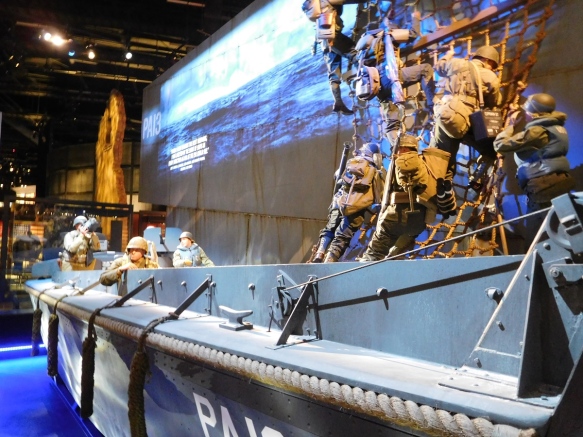 That same helpful and informative docent also clarified for me which gun was which in one exhibit case. (My only exhibit criticism: I sometimes had difficulty matching an artifact with its identifying label.) He pointed out the differences between the M1 Garand—the ubiquitous infantry rifle of World War II—and the adjacent M1 carbine, which he told me fired smaller, pistol-caliber bullets. He also explained the difference between automatic and semiautomatic weapons and how they worked. (Yes, I was interested; no, I’m not planning to buy one.)
That same helpful and informative docent also clarified for me which gun was which in one exhibit case. (My only exhibit criticism: I sometimes had difficulty matching an artifact with its identifying label.) He pointed out the differences between the M1 Garand—the ubiquitous infantry rifle of World War II—and the adjacent M1 carbine, which he told me fired smaller, pistol-caliber bullets. He also explained the difference between automatic and semiautomatic weapons and how they worked. (Yes, I was interested; no, I’m not planning to buy one.)
Other exhibit cases showcased the typical gear soldiers carried, which differed between Europe and the Pacific. I wished my father could have been here to tell me what carrying and using this gear had been like. I think he would have enjoyed sharing those memories.
The World War II gallery covers a lot of ground, from the contributions of the Women’s Army Corps to the heroics of medics, from the strategizing of generals to what life was like for infantrymen. Stories of individuals who exemplified various Army roles help humanize the hardware-heavy gallery. It was a lot to take in. I bypassed videos and glossed over some exhibits, leaving more to explore on a future visit.
That’s Not All, Folks
World War II’s presence extends beyond the Global War gallery. The special exhibition on the second floor, The Art of Soldiering, showcases artworks from the U.S. Army art collection that depict the experiences of soldiers from the Civil War through World War II to the present. Most were created on or near the front lines. On display are paintings, drawings, cartoons, even a meticulously detailed model of a Civil War winter camp cabin crafted by a Union soldier in a hospital while recovering from a bullet wound.
I recognized some artworks from my book Life’s Picture History of World War II. I was also surprised and thrilled to find The Battle of Lookout Mountain, a painting created by James Walker in 1864. This panoramic picture spans the front and back covers of my treasured Golden Book of the Civil War, an American Heritage young readers book my parents gave me when I was in grammar school and that I have read countless times since.
On the third floor are two more small exhibits: Medal of Honor Experience, about the nation’s highest award for valor; and Nisei Soldier Experience, about Japanese American soldiers during World War II.
Three Words
After lunch at the museum café, I headed out. I had one last misson: to see if my father’s 40th Division was represented on the long row of division plaques displayed on a wall outside. Walking down the row, I soon spotted a plaque bearing the 40th’s distinctive sunburst insignia.
I’ve seen this insignia on uniforms worn by actors on TV. The “Sunburst Division” had roots in California, so maybe 40th Division uniforms were easy to come by in Hollywood.
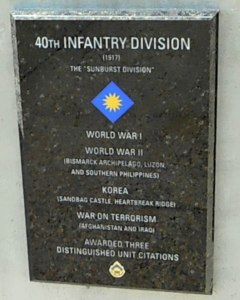 According to the plaque, the 40th Division served in other conflicts after World War II—in Korea and in Afghanistan and Iraq. So apparently, it is still an active division.
According to the plaque, the 40th Division served in other conflicts after World War II—in Korea and in Afghanistan and Iraq. So apparently, it is still an active division.
I stooped down to examine the small division emblem at the bottom. Along with the sunburst, it bore three words that brought a start of recognition. They were the words a soldier spoke to my older sister Judy at my father’s funeral, as he inserted three spent cartridges into the folds of the American flag he then handed to her:
“Duty. Honor. Courage.”
I did not know then why that soldier chose those words. Now I do.

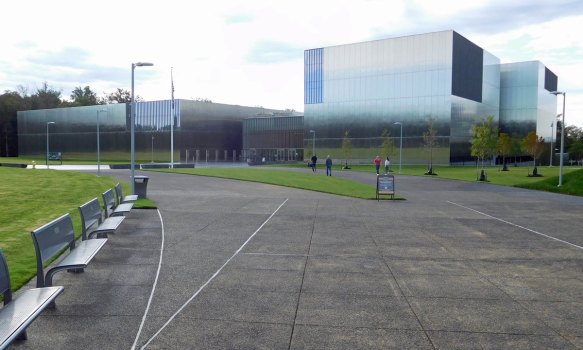
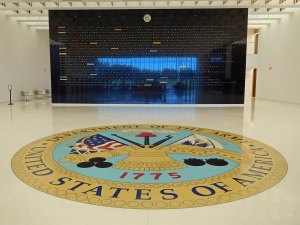
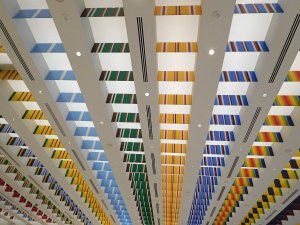
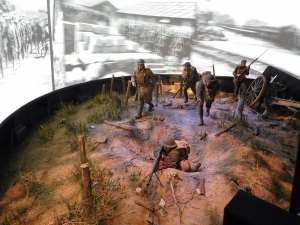

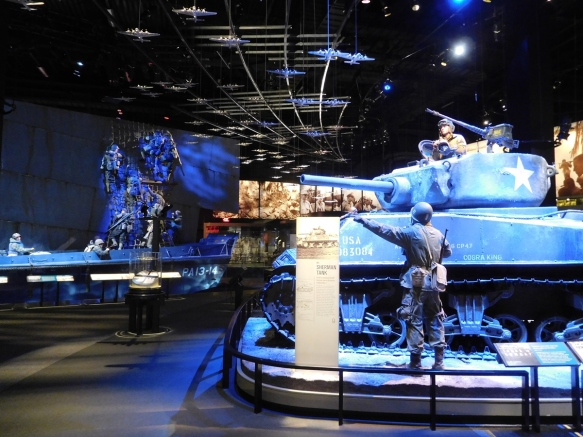
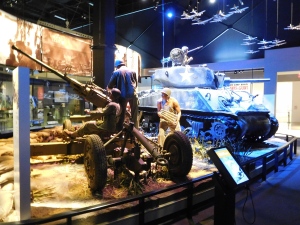





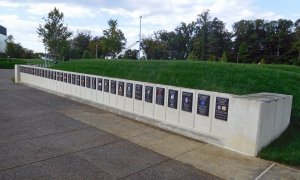

Pingback: “Bike Walk Drive” at 100 | Bike Walk Drive